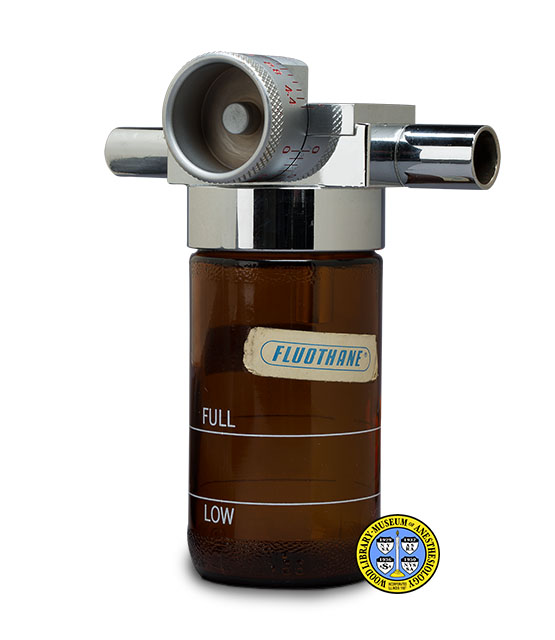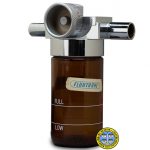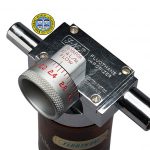F. N. S. Vaporizer
In 1949, Mr. George W. Newton (1920-2015) founded Newton Instrument Company in Durham, North Carolina. A former employee of Duke University, his company produced two anesthesia devices closely tied to that institution, the Duke Trilene Inhaler and the Fabian Newton Stephen (F-N-S) Fluothane Vaporizer. Both of these devices were made at the request of C. Ronald Stephen, M.D. (1916-2006). Dr. Stephen served as Professor of Anesthesia at Duke University, and Chief of the Division of Anesthesia at Duke Hospital, from 1950 to 1966. His Division conducted the earliest research in this country on the new liquid anesthetic, halothane. One member of this team was Leonard W. Fabian, M.D. (1923-1994.) Halothane (brand name Fluothane) was introduced in Great Britain in 1955. It was the first of a new generation of non-explosive inhalation anesthetics. It required more precise calibration than could be achieved with existing equipment, and new vaporizers were invented to fill that need. The first of these was the Cyprane Fluotec, introduced in 1957. The second was the F-N-S Vaporizer, introduced in 1958.
Catalog Record: F. N. S. Vaporizer F-N-S Vaporizer
Access Key: aqsn
Accession No.: 2018-01-15-1
Title: F-N-S Fluothane vaporizer / [designed by Leonard W. Fabian, George W. Newton, and C. Ronald Stephen].
Author: Stephen, C. Ronald (Charles Ronald), 1916-2006.
Author: Fabian, Leonard W. (William), 1923-1994.
Author: Newton, George W., 1920-2015.
Corporate Author: Newton Instrument Co.
Title variation: Alt Title
Title: Fabian Newton Stephen Fluothane Vaporizer.
Title variation: Alt Title
Title: F. N. S. Vaporizer.
Publisher: Durham, North Carolina : Newton Instrument Co., [between 1957 and ca. 1960].
Physical Description: 1 vaporizer : metals (including chrome and aluminum), glass, paper ; 16 x 12 x 6.5 cm.
Subject: Anesthesia, Inhalation – instrumentation.
Subject: Halothane.
Subject: Vaporizers.
Note Type: General
Notes: The first and second years in the range of possible dates of manufacture are based on the corporate history of the manufacturer (Newton, 2000.)
Described from the perspective of the user, with the calibration dial and the markings “Full” and “Low”, facing forward.
Note Type: Citation
Notes: Brennan HJ. A vaporizer for Fluothane. BJA. July, 1957. 29(7): 332-333.
Note Type: Citation
Notes: Fabian LW, Newton GW, Stephen CR. Simple and accurate fluothane vaporizer. Anesthesiology. March-April, 1958;19(2):284-287.
Note Type: Citation
Notes: Fabian LW, Stephen CR, Bourgerois-Gavardin M, Dent SJ. Performance characteristics of vaporizers for administration of fluothane. Anesthesiology. January-February, 1959;20(1):27-30.
Note Type: Citation
Notes: Fabian LW, Newton GW. Anesthetic vaporizer. US Patent 2,942,528. June 21, 1960.
Note Type: Citation
Notes: Giesecke AD. First use of halothane in the United States, C. Ron Stephen (1916-2006). Bulletin of Anesthesia History. July/August 2008;26(2):1, 4.
Note Type: Citation
Notes: MacKay IM, Kalow W. A clinical and laboratory evaluation of four fluothane vaporizers. Canadian Anaesthetists Soc J. July, 1958; 5(3):248-261.
Note Type: Citation
Notes: Newton D. Newton: The First Fifty Years. Raleigh, North Carolina: Bedford Printing, 2000.
Note Type: Citation
Notes: Newton Instrument Company File. Archives. Located at: Wood Library-Museum of Anesthesiology, Schaumburg, Illinois.
Note Type: Citation
Notes: Stephen CR. A chronology of events. In: Fink BR, ed. Careers in Anesthesiology, Vol. II. Park Ridge, Illinois: Wood Library-Museum of Anesthesiology, 1998:61-90.
Note Type: Citation
Notes: C. Ron Stephen Biographical File. Archives. Located at: Wood Library-Museum of Anesthesiology, Schaumburg, Illinois.
Note Type: Physical Description
Notes: One vaporizer; Consists of a metal vaporizing head that screws into a threaded, glass jar; The head unit alone measures approximately 7.5 x 12 x 6.5 centimeters; This unit is roughly rectangular in shape, mounted on a cylindrical base or cap; An uptake tube extends approximately 2 centimeters below the cap; An integrated connector, approximately 1.5 centimeters in diameter, emerges from the left side of this unit; Another integrated connector, approximately 2 centimeters in diameter, emerges from the right side of the unit; The top of the head is marked: “F-N-S [new line] FLUOTHANE [new line] VAPORIZER [new line] NEWTON INST. CO. [new line] DURHAM, N.C.”; It is marked on the back with the serial number: “C0002343”;
A calibration dial is mounted on the front of the unit, directly above the “full” and “low” lines; This dial is marked in red, from left to right: “0, 0.4, 0.6, 0.8, 1.2, 1.6, 2,0, 2.4, 2.8, 4.4”; On top of the head unit and behind the dial, an extension made of the same dull metal as the dial is marked: “% VAPOR [new line] AT 4 L./M. [new line] FLOW”;
The jar alone measures approximately 11 centimeters in height x 5 centimeters diameter; It is made of amber glass which is textured near the top and bottom; The jar is marked with two horizontal white lines, one labeled “FULL” and the other “LOW”; The flat base of the jar is unmarked; Two paper labels, each reading: “FLUOTHANE ®”, have been glued to the glass, roughly on opposite sides of the jar.
Note Type: Reproduction
Notes: Photographed by Mr. Steve Donisch, January 15, 2018.
Note Type: Historical
Notes: Mr. George W. Newton (1920-2015) worked as an instrument maker for the Duke University Department of Physics from 1939 to 1947. At that time, the “physics shop” also made surgical instruments. After leaving Duke, Mr. Newton founded Newton Instrument Company in 1949. Shortly thereafter, he was hired as a consultant to help set up a separate instrument shop for Duke’s Department of Surgery. Ties with Duke continued as Newton Instrument Co. developed new medical instruments for the University. These included two anesthesia devices, the Duke Trilene Inhaler and the Fabian Newton Stephen (F-N-S) Fluothane Vaporizer. Both were made at the request of C. Ronald Stephen, M.D. (1916-2006). Dr. Stephen served as Professor of Anesthesia at Duke University, and Chief of the Division of Anesthesia at Duke Hospital, from 1950 to 1966. Dr. Stephen was the first physician in the United States to receive samples of the new liquid anesthetic, halothane (brand name Fluothane.) His Division conducted the earliest research in this country on halothane. One member of this team was anesthesiologist Leonard W. Fabian, M.D. (1923-1994.)
Synthesized in Great Britain in 1951 and clinically introduced there in 1955, halothane was the first non-explosive inhalation anesthetic developed in over a century. Eventually, the ready availability of halothane led to a ban on the use of volatile anesthetics, principally ether and cyclopropane, in U. S. hospitals. Halothane required more precise calibration than could be achieved with existing equipment, and new vaporizers were invented to fill that need. The first of these was the Fluotec, introduced in 1957 by the British manufacturer, Cyprane. The second was the F-N-S, introduced in 1958. A patent for the F-N-S was granted jointly to Dr. Fabian and Mr. Newton in 1960.
The F-N-S was widely used, but it had only a brief period of commercial production. In his memoire, Dr. Stephen states that it “did not compensate for the changes in temperature associated with vaporization”, and that it was outdone in this respect by the Cyprane Fluotec (1989, page 76.) Halothane fell out of favor and was replaced by the newer agents isoflurane and desflurane. Newton Instrument Co. continues in operation today, but no longer makes medical instruments.
Note Type: Exhibition
Notes: Selected for the WLM website.



